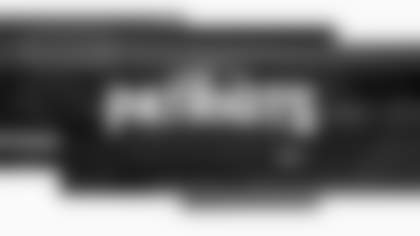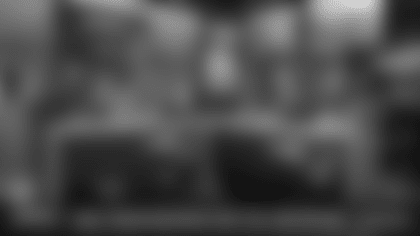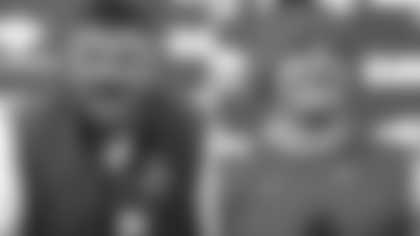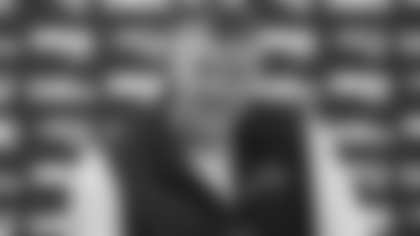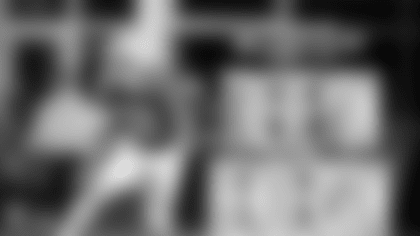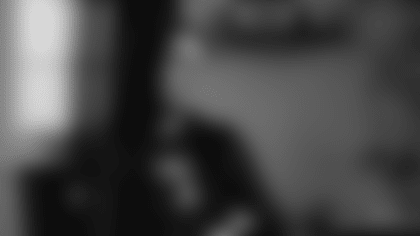PATRIOTS DIRECTOR OF PLAYER PERSONNEL NICK CASERIO
PRESS CONFERENCE
April 27, 2019
NC: I appreciate everybody's help and cooperation here today. Sorry for the wait. Just trying to put the finishing touches on a few things here today. Just to go back and kind of review the picks that were made. We went into the day with seven picks I believe and ended up picking five players, starting with the fourth round there with Hjalte Froholdt – that's as close to Danish as I'll probably get on that one. Interesting story, I'm not sure who had more enjoyment on that pick – Bret [Bielema] or the kid but Bret was pretty involved on the phone after the pick, so they can talk about their recruiting days when he brought him into the program. [He's an] interesting player. He started his career as a defensive lineman and they he transitioned to the offensive line and then he ended up playing basically three years as a starter and never missed a game. He played against a number of good players and a number of good people. He's smart, got good size. He's got pretty good playing strength. He can play multiple positions inside there. He's a good football player against good people so he kind of fits the mold of some of the other players that we talked about here a little bit over the past few days. And the second pick there in the fourth round, we picked at 133 and then traded out of 134 and picked Jarrett Stidham, the quarterback from Auburn. He's another player who transferred, from Baylor. A lot of people probably know his background, leaving Baylor and then going to Auburn. He's a pretty productive player. The system is probably a little bit different relative to what he's going to play in offensively here, but he's a really smart kid. We had a number of interactions with him along the way. He's a smart player who takes care of the football with pretty good arms strength. He's fairly athletic, though not a running quarterback but he has decent movement skills, so I'm sure he'll be competitive with the rest of the players that we have at the position. Then we moved 134 out with the two fifths – that was the one of the Rams trades I think, and then picked with that first fifth-round pick, we picked [Byron] Cowart, the defensive lineman from Maryland. He started his career at Auburn. There's a lot of good football players on that team at Auburn, some of whom got drafted, some of whom are going to get drafted next year. He transferred to Maryland and played defensive end. He was a a five-technique in their kind of three-man front. They were really a 3-4 defense so he played a little bit more five-technique. He's probably a little bit more of a run player. I mean, this guy is really thick when you see him. He's well-built, he's really strong and plays powerful at the point of attack. He did some decent things at Auburn and he did some decent things at Maryland as well. And then with the second pick there, we drafted the punter from Stanford [Jake] Bailey. He's a pretty athletic kid, a great kid, great traits, smart, mature – so it's really nothing more than competition. We'll see how it goes. Our thing is we really don't make commitments to anybody how it's going to go, the competition sorts itself out and we'll let it play out. And then move those seventh round picks around, kind of got rid of them and ended up with the one pick there at end and took [Ken] Webster, the corner from Ole Miss. He's a really, really good player in 2016. He had some injuries that he sustained in '17 – whatever year that was – then he kind of worked his way back. I'd say he's similar to [Keion] Crosen just from the standpoint of [he has] outstanding testing numbers. I mean, [he's] really explosive in terms of his speed and his explosiveness – I mean like eye-popping numbers. Now, there's an element that has to translate over to the field, but from a physical, athletic trait standpoint, there's a lot of good qualities and he played against some pretty good people on a weekly basis. So out of those five players, plus the players we picked up here over the past few days, there will be some work here to be done. We have post-draft free agency and there will be some moving parts and then we'll just transition to the next phase of the off-season program. Our players will be here on Monday for phase two, where we actually start to get involved a little bit more on the field with the coaches and with the players. Then we'll continue the team-building process here throughout the spring. So I'm sure there will be some moving parts between now and September when we play our first game. Nothing's really set in stone so we'll take it one day at a time and just try to continue to improve the team as best we can. I'll take some questions from here.
Q: Jarrett said he met with you for quite a while at his pro day. How much did he impress you in that meeting and how much did that play into picking him?
NC: Everything goes into it. I mean, everything goes into it, so it's just part of our process that we go through. But he's a smart kid, pretty mature and picks things up well. So, we'll see how it goes. Like I said, he's going to transition into a system that's a little bit different in terms of play calling and some of the other things he's going to be asked to do here. He's an impressive kid. He's very mature, so we'll see how it goes.
Q: Did the system at Auburn hold him back a little bit? It seems like he was talking about they didn't necessarily find their identity and in retrospect, he said, I think we should have opened it up more.
NC: I think kind of what we talked a little bit about yesterday, the system is the system so kind of we're moving forward and whatever actually happened in the past doesn't really have any bearing on what we're going to do. The things we're going to ask him to do may be similar, they may be different. So how he handles our information, our volume, our system – we'll see how that goes, because I think you have to kind of evaluate the player from a skill standpoint. The system component factors in to some degree but in the end, you have to sort of look past that and look forward and transition them forward into our system and see how they assimilate into the things we're going to do.
Q: How different is the information that you're trying to gleam when you're going to visit a kid for the first time versus when you then later host him on a visit having already met with him?
NC: I'd say along the way, what you're really trying to do is look for confirmation or if there's any sort of discrepancies, like where the school said one thing and, well, we found something different. If there's a gap, then you try to fill that gap or has there been a consistent pattern the all the way throughout. I wouldn't say it's necessarily anything different that you're trying to do. You're trying to confirm what you have. 'OK, is this the information? Does this seem accurate? Does this match up? OK, we'll we have a little bit of a gap here, OK let's delve a little bit further into that.' Along the way, we're trying to arrive at the same point to create one profile of the player and say, 'OK, here's what we think it is based on all the information that we accumulated to this point.' So wherever the interaction is, it's not necessarily different. The further along you get into the process, maybe there's something specific that you really want to drill down on.
Q: Knowing it's only a few days of work at the Senior Bowl, how valuable was it to see Jarrett in that environment, knowing that the offense he was going to be running there was different from what he ran in college and might be more similar to the offense he's be running in the NFL?
NC: The great thing about the Senior Bowl is that you're seeing some of the best players. There have actually been some underclassmen who have been incorporated into that mix. So you're seeing them against good competition and it's a different dynamic or different situation that they've been placed in. You're kind of taking them out of their environment that they've been in and kind of giving them something new and seeing how they handle it against good people. A lot of those players that were there I'm sure will go back and look to see who was at the Senior Bowl, how many players were drafted, how many players are on rosters, and there's probably going to be a decent correlation. So you get an opportunity to evaluate them in a different environment and see how they handle that transition or something different.
Q: Is the scheme part of it important? I remember Jimmy [Garoppolo] went to the Senior Bowl in 2014 and was probably pretty different from what we was running at Eastern Illinois and let him see something different?
NC: I think the Senior Bowl – everything is so watered-down because even the team that are there, they're really not putting their system in place. They're basically giving the players – 'OK, here's what we're going to do.' I mean, look, they can run two coverages on defense and the volume of plays you can actually run is going to be limited, so it's a little narrow in scope relative to what they're actually going to get. So it's just something new or something different and you can see how they handle that. Because the other thing too is, you're throwing to a guy you've never worked with before. Timing, body language, execution – there's a lot of different elements, so honestly, you're just seeing how they handle the environment relative to the other players that they're going against.
Q: In the fifth round when you moved up to selection No. 163 to take Jake Bailey, was that a matter of feeling the need to jump ahead of teams with anticipation of who they make take at 164, 165, or 166?
NC: Not necessarily. It might be more of like, we have a lot of picks. We're probably not going to be able to use them. If we're going to pick players – I mean, there's only so many players that we can pick or you start to run out of players at some point that we're actually going to pick. It's supply and demand, like how many players. If you look at our team, you only have so many spots. We have a pretty competitive roster but you can only go up to 90, so if you just start adding players, well, it's going to come at the expense of somebody else. I think it's more of a situation where just you kind of have some picks and you might not be able to use them. Maybe you just move up a few spots and it could save you somewhere else along the way.
Q: Was this a good draft to find potential starters in later rounds? Was depth one of the strengths of this overall draft?
NC: Yeah, I mean, I think it all depends on what you're looking for and what you're trying to do. Our system and our process is pretty similar just wherever we are, so we just try to find players that we like and we think fit. Look, the draft, it's an inexact science. For me to sit up here and tell you anything different – I mean, look, everybody puts a lot of time into a lot of the resources and even with that sometimes it's a 50-50 proposition. We just try to work through our process and try to stay consistent. The one thing that we try to do is – we talked about this last night – work across and work up and down, and even when we're picking players, whatever round it is, sometimes our conversation is, 'Well, look, who's been the most consistently highest graded player.' Then pick that player as opposed to, 'Well, there's another guy over there. Yeah, we like him.' But then to take a guy maybe a little bit lower just to take him at another position. Those conversations are really organic because it's all predicated on what's in front of you. That's the one thing you try to do. We just try to do the best job that we can with the opportunities that present themselves.
Q: What's the focus now for the college scouts at this point of the calendar?
NC: It's a great question, Chris [Price]. So basically, our road scouts, so throughout March and a little bit of April, you kind of have the pro day circuit, right? And then as a part of that, you're actually starting to work on some of the spring scouting because you have the junior days with junior prospects – height, weight, speed. Get some of that information. You can start to accumulate some background information while you're at the school at the actual pro day for next year. Then once the pro days are done then the area scouts are focused on the 2020 draft. So our guys were here for the past three or four days and while the draft is going on, they're watching the draft and they're watching prospects in their area for next year so we can put together our spring prospectus. It's a continuous moving target. Our guys do a great job. They take a lot of pride in what they do and it shows. They're as important to the process as anybody because a lot of the players that we pick is based on a lot of the work and information that they've accumulated that we have in our database that we resort to, I'd say, on a pretty regular basis. Even once they transition from college to pro, they kind of flip in the system and then we still have all of that information so if it's a player on another team that's not here, OK, well, somewhere along the line if he comes into our program, let's go back and look at the information. What did we have on him? Sometimes it matches up or sometimes it helps you make a decision on a player that otherwise you wouldn't have that information.
Q: How much stock do you put into tape that wasn't from 2018 with these players?
NC: It's a great question. It's a great question. Everything's important, so obviously, when there's a little bit of a gap in time like that, you're kind of able to maybe look at a player and say, like, peak performance – what did that look like? Then see, OK, maybe it's taking a little bit of time to get to that same level of performance. These players, they mature over the course of hopefully two to three years, so what they were as a sophomore may be different than what they are as a senior. You can kind of see that progression. Not that it's really germane to this discussion, but like Josh Allen, OK, from Kentucky. So here was a player who he could've come out as a junior. He didn't come out so he went back to school and he basically made himself a top 10 pick based on his performance, his production, his play and it's a credit to him so there's a good example of a player who went from '16 to '17, was a good player, went from '17 to '18 and made himself into one of the best players in the draft. Depending on the circumstance and situation you might be able to use some of that information but what they're doing currently is relevant. Then you have to be able to say, 'OK, here's what we think it's going to be. This is what it was. He can get back to this level or not.' So we'll have to test that when they get here, but in certain situations it may be a little bit more applicable than others.
Q: Was this draft one that you felt comfortable in all the way throughout? Did you ever feel sped up or was this an easier draft relative to past years?
NC: It's a good question, Tom [Curran]. I think it's pretty consistent year to year and we just try to stay true to our process throughout the way. I wouldn't say that we've deviated much from that. I mean, we go through, set the board, grade the players, look at the board and take the information and just as the players come off – there's a reactionary element. You can try to project as much as you want. Like, OK, this guy's going to go here, this guy's going to go there, what if we do this – OK, you can spend some time on that. But it's really more as it's happening. OK, then what's the application? Then make your decision, OK, and if you lose a player, OK, you go to the next guy. You can't look back, you just have to move forward. The group that we have does a phenomenal job. We've worked together on a pretty consistent basis over the last however many years. They make it easier on all of us because of how well and efficient they do their jobs.
Q: Was there ever a period where it felt frantic? Are you ever scrambling to make calls to teams about making a trade or have those calls already happened leading up to being on the clock?
NC: A combination of both. A combination of both because trade's are very player specific and very player driven based on the needs or interests of the other team. We'll reach out, they'll reach out, 'Hey, what do you think?' And then we'll look at it and we'll make a decision. 'OK, well if we do this here's what would happen.' There's a reactionary element and you just have to make a decision. You just can't vacillate. You just have to make a decision and move forward and whatever the circumstances are. It's kind of like in a game. Like, OK, what happens on second down, alright, boom, got to transition to third down and go to the next play. To a certain extent it's similar to a game-like element. Like I said, we're blessed to have a lot of great people that are a part of the process that make it very efficient, very clean. That portion of it, I would say, has been pretty consistent here for the last however many years so it's really more of a credit to them.
Q: Do you have to factor in the total number of bodies that you want to add?
NC: You have to look at where you are from a team standpoint. So I think we started the day, we were probably roughly 70 players on the roster. So, we had 12 picks. We ended up picking ten, so there's 80. We'll sign some players after the draft. Every player that you add, OK, if you go over 'X', you're going to have to make a decision on somebody else. That's where you can have all these draft picks, OK, well how many roster spots do you have? Some of that plays into it. They'll be some movement probably here over the next however many weeks. Guys will come on, undrafted players will come on, players will come off and that's part of we're evaluating our team along the way and we're just trying to put together as competitive a group as possible, really, kind of looking ahead to training camp. The spring's important, training is important, OTA's are important, but the most important thing is where are we going to be in training camp, and then just trying to set our team up so that we can have a competitive situation come August.
Q: Would adding 12 players have been OK? Could the roster have handled that or were you looking to offload some of them?
NC: I think it's really dependent on who are we talking about, who are we picking? The type of player, the quality of player that you're actually picking and is it realistic like, OK, are they really going to have an opportunity to make the team or maybe they fit into a different category or classification. Ten, 12, nine, eight – we've drafted as little as four or five players one year then we've drafted ten, 11, 12. It's constantly a little bit of a moving target so there's not one specific formula like, 'OK, we need this many players in this draft.' You do have to manage your numbers because you can only have so many that you take to training camp.
Q: When you are trading into a spot with another team, is there transparency about who wants which player?
NC: No, they're not telling you who they're picking. I mean, you might consummate the trade and then just ask them, 'Well, who are you picking?' And then say, 'OK, got it,' and then just move on. Like, once you agree to the trade, 'Oh, who are you picking? Oh wait, no, hold on. We're not going to...' No, you can't do that because both teams have to communicate with the league, right? So, let's say you call me, 'Hey, want to do a trade?' 'OK, what's the compensation?' Boom, boom, boom, boom, boom. 'OK, we agree to that.' 'OK, great.' Both teams have to call the league and then they tell you, 'Alright, you're confirmed. We have a trade, we have an agreement, you're on the clock.' Like, it's not, 'Well, who are you picking? Oh, OK. Well, hold on...' I mean, you can't do that. So, it'd be great, but you can't do that.
Q: Obviously, with Froholdt, you can lean on Bret Bielema a little bit on that pick. Is that a similar process to when you were signing a player that Josh McDaniels worked with at the Rams or the Broncos? Or is it different because you're still projecting a player to the pros from college?
NC: That's a good question. That's a really good question. I think wherever you can accumulate information that you think can help you in your evaluation or your assessment is important, whether it's a former coach, whether it's a former teammate, a former player. I mean, look, you want them to be honest – just want an honest answer. Like, 'OK, what did you think of this player? What was he like on a daily basis?' So, wherever you can gather information, it's important, and I would say there's varying levels of sources at different places. There's the ones that you can rely on. There's others that, OK, they'll give you some information, but it is real information? So, you have to work through that, but you try to use whatever resource and tools that you can before a player comes into your program just to see whether or not this is a player that actually fits and here's why he may or may not.
Q: You mentioned that you might go back to previous years that players have played to help contribute to the evaluation. How far back are you guys willing to go at times? Somebody like Byron Cowart was the No. 1 recruit in the country coming out of high school. Is that something that would get a player on your radar as far as being a special athlete?
NC: That's a good question, Phil [Perry]. You build a file, but as we know, some of those recruiting rankings and services sometimes are a bunch of hot air. So, if a player was highly thought of coming out of high school and is highly recruited, it's in the background, it's in the notes. And then ultimately, it's like a player – OK, you can think of players highly thought of in college and then when he gets to the NFL, respectfully, none of that really matters because what's going to matter is your performance when you're actually here. So, in some respects it's similar to the high school situation, but there's a lot of players that were pretty highly recruited. They were whatever they were coming out, so you're going to go back not necessarily and use that, but OK, obviously he was a well thought of player. Then once he gets here, then what does he do when he's actually there?
Q: You mentioned a five-technique in a Maryland scheme or Auburn scheme. Do you view him similarly in terms of his transition to the NFL? Is he like a Lawrence Guy type where you can use him in a variety of different spots?
NC: Yeah, I mean, we're obviously a multiple front, so we play a lot of different fronts and there's a lot of different areas that they can play. I mean, Trey Flowers played defensive end, sometimes he was a zero-technique over the nose in some of the sub-fronts. I mean, trying to figure out where he's going to best utilize his skills and his physical attributes – I mean, he's 6-3, 300 pounds, so he's kind of a bigger type of player versus Derek Rivers and some of those edge guys who are at 255 – like Winovich – 255, 260. So, they're a little bit different. So, whether or not he can move on the front here a little bit, we'll find out when he gets here.
Q: You didn't draft a tight end. Was that reflective of the way the board fell in front of you, or was it reflective of how you guys felt about that position in this draft? Also, Jake Bailey is a right-footed punter, but we are used to left-footed punters here. How much did the fact that he's a right-footed punter play into it?
NC: Not much. I mean, you're just evaluating the player's skills – I know that's been a topic of discussion that we've had 56 left-footed punters since Bill's been here, but punting, there's a lot of different things that go into punting. So, I mean, it's just the spin of the ball is going to be a little bit different and those types of things. So, I think you just look at the player on its own. To your question on the whole tight end position, I mean, look, we work across the board and we try to rank the players accordingly. I mean, were there opportunities for us there? I mean, possibly, so it's always relative to what are your other options, what else are you looking at?
Q: Jarrett Stidham talked about how he talked to you guys about needing to improve his feel in the pocket. Is that something that's easily coachable and how do you evaluate that when you want to fix something like that?
NC: Yeah, I think the big thing with any player, you just try to give them a foundation – the system element. OK, come in, get a foundation, learn our terminology, learn our techniques. And then the on-field coaching that takes place, that's going to be up to guys like Josh who work with the quarterbacks. So, there will be a building block progression that goes into it, and we'll try to identify – you can't give a player like, 'OK, here are 12 things you need to work on.' OK, here are the things that are probably – 'Let's focus on these initially. Once you get that, then move to the next thing.' Whatever a player's skill is or whatever some things that we feel are going to improve and make him a better player, we try to identify, try to give him information and here's how you can improve it. I mean, it's a step-by-step process. The biggest thing for them – we talked about this last night – will be for them to get here and just assimilate to our program, get on our program and kind of start to establish a little bit of routine for themselves because everything that they do is going to be brand new.
Q: In the evaluation of Stidham, what were the games or moments that most stood out in terms of leadership and intangibles?
NC: Yeah, there's never a moment. It's really a culmination of everything. This guy was a two-year starter in a good program, playing against good people on a weekly basis. So, it's really never one thing. It's always a combination of everything put together that go into the player's evaluation.
Q: You have several guys coming off of injured reserve or not being used much from last year's draft, as well. How much does that factor into some of the decision making in this draft in terms of how you draft positions?
NC: It's a good question. It isn't necessarily going into the decision-making – I mean, those players are at a different stage in terms of their overall development, so this will be an important offseason. Really, a lot of them have been training, call it since January or February, because even if they were limited during the season, there are things that they can do. So, they're further ahead of where they were relative to last year. Now, let's see how much further ahead they can get. I mean, they're going to have some opportunities in front of them here. These are the players that the spring is really advantageous for – go through a full offseason of training, get on the field, the coaching sessions, OTA, phase three. So then you can see over the course of three, four months how much progress have they made relative to their first season. I mean, going back, James White, Trey Flowers – I mean, those guys basically didn't play as rookies. Shane Vereen hardly played. Then they transitioned into their second year and you're just kind of looking for a progression and see if they can take any steps really to give themselves an opportunity to be competitive when we get to training camp.
Q: When you look at linebacker this year, you've got a couple guys coming off of last year that may have shown you something, so do you decide you don't need to draft at that position?
NC: Yeah, it's the same thing. It's not necessarily need-based as much as it is player relative to what other options you have when you pick the player or draft the player.
Q: Now that these picks are made, how does that crystallize for you guys moving forward if you want to make a trade for a veteran player who is already in the NFL?
NC: Yeah, we'll take it one day at a time. I mean, nothing's going to happen overnight. So, I mean, obviously, a lot of players have been added to 32 teams in the league, including ours, so we'll assess where teams are, kind of look back on the roster-building phase of it and kind of transition into – there will be another phase here that we'll go into, call it from now until the middle of June, middle of July, so I'm sure there's some players that will factor in here at some point.






